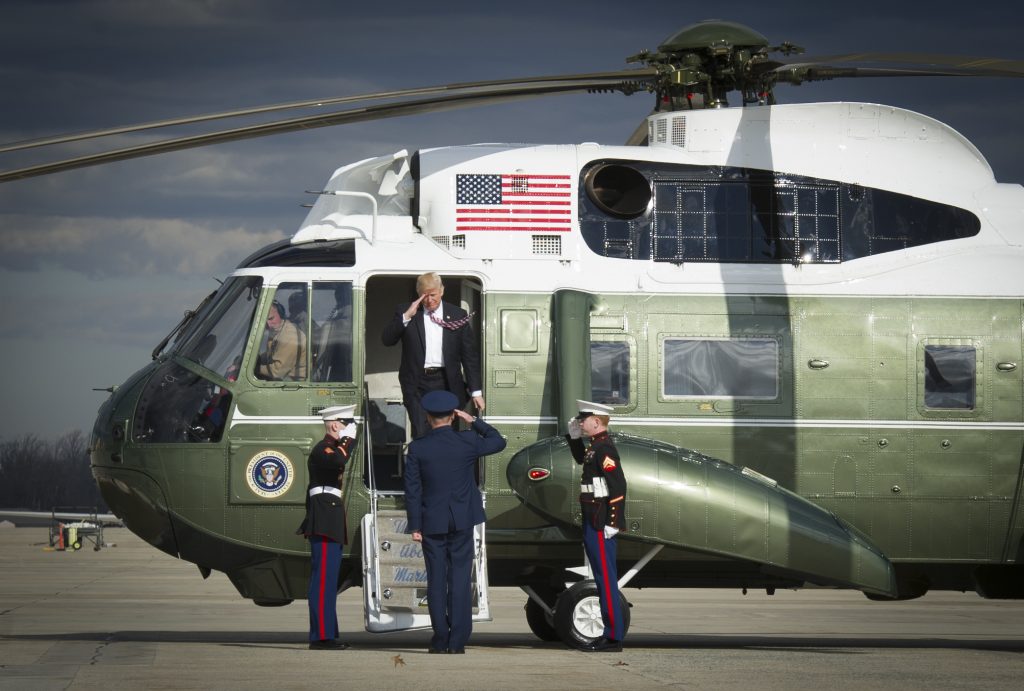
President Trump debarks Marine One. The current fleet of VH-3 helicopters is aging.
President Trump, clearly feeling some heat after the Treasury Department noted the national debt ballooned 17 percent to $779 billion this year, announced yesterday that the defense budget would drop to about $700 billion in fiscal 2020. Trump told his Cabinet this could happen, “because now that we have our military taken care of, we have our law enforcement taken care of, we can do things that we really weren’t in a position to do when I first came.” Now, we’re betting there are quite a few generals who’d be willing to advise the president that the military hasn’t entirely “been taken care of,” but the announcement is a clear signal that the budget trend is no longer upward. Dan Goure, now with the Lexington Institute, starts his analysis of defense spending by saying 2019’s budget is “a down payment” on a stronger, more ready military. Read on! The Editor.
Today’s national security leadership face a dilemma not unlike that which confronted the Western allies in the 1930s. Faced with growing great power threats in both Europe and Asia, they knew it was essential to build up their militaries. However, the ongoing effects of the Great Depression and bad economic policies caused them to hesitate when it came to increasing defense spending. As a result, France and Great Britain were ill-prepared when war came. Current U.S. defense leaders are warning that the same situation could occur again.

Dan Goure
The Trump Administration, with the support of Congress, has made a down payment on its plan for a massive buildup of the U.S. military to avoid that scenario. The recently passed 2019 National Defense Authorization Act provides for a defense budget of $717 billion. The corresponding appropriations bill was signed by President Trump on September 28.
The topline for the 2019 defense budget establishes a modest increase over the $700 billion provided in 2018. However, that defense budget was nearly $100 billion higher than the prior year’s budget, the last of the Obama presidency, and some $60 billion more than had been requested for 2018.
The strategy was to build a budget that reflected the new National Security Strategy, in general, and the need to prepare for competition with other great powers, in particular. So, the administration front-loaded the defense budget to address the crisis in readiness, jumpstart modernization and generally rebuild the U.S. military.
In response to the dictates of the new National Security Strategy and confronted with a geyser of additional dollars, each of the military services lost no time in defining a new, larger and much more expensive force structure. In perhaps the boldest claim yet for more money, Air Force Secretary Heather Wilson announced at the Air Force Association conference that her service has to grow the Air Force from 312 to 384 squadrons to meet the challenges imposed by an era of great power competition. This increase would include five bomber squadrons, seven fighter squadrons and 14 tanker squadrons. Manning the expanded force would require 40,000 more airmen.
The other services had already laid down their force structure markers. In late 2016, the Navy proposed a battle force of 355 ships, an increase of 76 grey hulls over the current fleet size and 47 more ships than the Navy’s previous goal of 308. Reaching the new, higher goal would require keeping older ships in service longer, as well as building between 57 and 67 additional vessels of various classes over the next 30 years. Around 15,000 additional personnel would be needed just to man the additional ships but the total manpower increase needed, including shore establishment, could be as high as 40,000.
The Army has long argued that just in order to meet current demands and fill personnel shortfalls in existing units it must grow the active duty force to 495,000 from its current size of 460,000. There would also be additional, albeit modest, growth in the Army National Guard and Reserves. President Trump had expressed his desire to see the Army increase even more, to 520,000.
In addition, the Army is modernizing much of its existing equipment such as Abrams tanks and Paladin self-propelled artillery, adding new capabilities including the M-SHORAD air defense system and even converting an Infantry Brigade Combat Team into an armored formation. On top of that, there are Chief of Staff General Mark Milley’s six modernization priorities that could lead to significant new acquisition programs.
How much more would this larger and more modern military cost? Acquiring additional B-21 bombers, F-35 Joint Strike Fighters and KC-46 tankers as well as all the other platforms to fill out 74 squadrons would undoubtedly require billions of dollars more for the Air Force acquisition accounts.
The Air Force’s earlier plan to add five fighter squadrons to the force was estimated to cost around $8 billion, excluding personnel and sustainment. One estimate is that $5 billion annually would be needed just to cover the costs of the additional 40,000 personnel the Air Force would need. To that, one should add an estimated $13 billion a year for operations and maintenance of the additional squadrons.
The Congressional Budget Office estimated that acquiring the additional 76 ships needed to reach the Navy’s force sizing goal would require an additional $5.4 billion each year just for the shipbuilding account between now and 2047. This is in addition to the almost $5 billion added by the Trump Administration for FY 2019. An increase of 40,000 in Navy strength could easily result in a $5 billion annual bill.
The Army is spending billions to upgrade its tanks and armored fighting vehicles. Adding more personnel, particularly to reach the goal of 540,000, would cost close to $10 billion a year. Overall, the additional costs for a bigger and more lethal Army could exceed $20 billion a year.
In total, the new force structure of the three services could require adding $50 billion to $75 billon to the defense budget for 2020 and beyond.
The Pentagon recognizes that it cannot expect further large increases in defense spending. So, where will the building find the additional resources necessary to fund the services’ ambitious growth plans? Defense Department leaders have acknowledged that they will have to find additional resources through savings which the department will be allowed to reinvest.
According to Robert Hood, the assistant Defense Secretary for legislative affairs: “I think the hope is we will find some efficiencies and savings in things, in significant amounts of dollars, that we can then reinvest into, be it hypersonics or whatever it might be that needs the dollars. That’s sort of our focus in trying to get us through the out years.”
The history of the Pentagon’s attempts to achieve savings through internal reforms is notable for the absence of successes. In 2011, then-Secretary of Defense Robert Gates announced a plan to save $178 billion in defense expenditures over five years, $100 billion of which would come from efficiency measures. To date, there is no evidence that any of the projected savings from reducing overhead were actually achieved. Any savings that were achieved came the old-fashioned way — by terminating weapons programs and cutting the size of the military.
Flat defense budgets going forward could be the best-case scenario for the military. There is the real possibility that the spending caps required by the 2011 Budget Control Act (BCA) will return for 2020. You may recall that the BCA imposed some $900 billion in mandatory savings over 10 years by capping both defense and non-defense discretionary spending. Congress provided the Pentagon with more funds in 2018 and 2019 because it suspended the caps for those two years. If Democrats take one or both houses of Congress in the November mid-term elections, the prospects for a budget impasse and the automatic imposition of the BCA caps goes way up.
The BCA only limits the amount that can be allocated for the base defense budget; it doesn’t limit spending for Overseas Contingencies Operations. Nevertheless, the decline in defense spending would be dramatic should the budget caps to be recomposed. Under a BCA scenario, base national defense spending would be capped at $576 billion in 2020, a drop of some $70 billion compared to the $647 billion provided for 2019. This is something over which President Trump has only limited influence.
Even if a fractured Congress could find a way to avoid letting the BCA caps take effect in 2020 and 2021, there are longer term budget problems that threaten the current defense buildup and would relegate the Services’ new plans to the realm of fantasy. As my colleague Loren Thompson has pointed out, rising interest payments on the national debt could suck all discretionary spending out of the federal budget. “Every 1 percent rate increase adds $200 billion to annual debt-service costs. At 5 percent interest, it would cost a quarter of the federal budget to sustain the current debt.”
There are good reasons to believe there will not be sufficient resources even to sustain the current military buildup. The idea that this country will pay for 74 additional Air Force squadrons, 47 more Navy ships and some 40,000 soldiers on top of that is difficult to take as credible.
Sullivan: Defense industry ‘still underestimating’ global need for munitions
National Security Advisor Jake Sullivan said that there are “no plans” for another Ukraine supplemental at this point.


























